Plant of the Month: Maiapilo a xeriscape gem for lower elevations
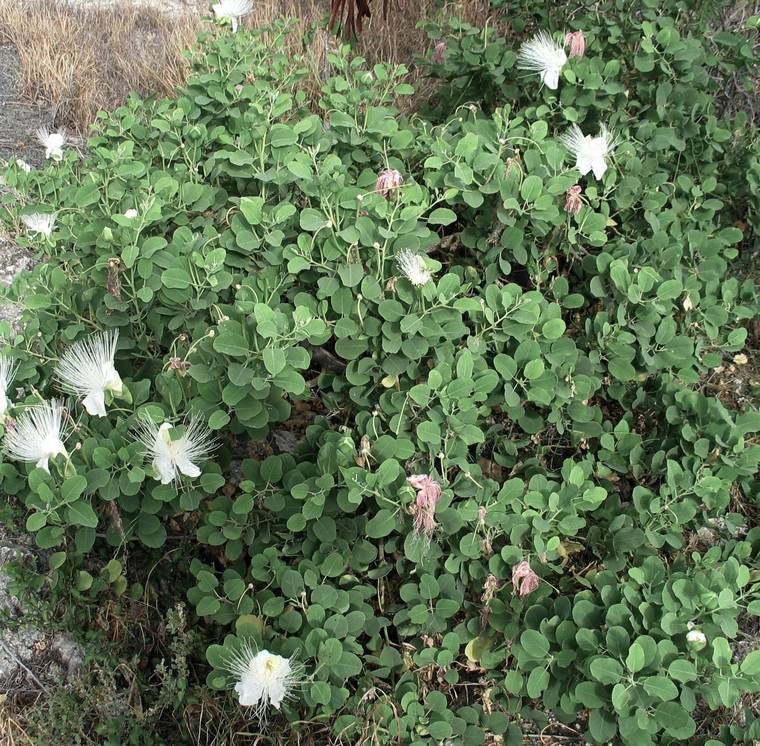
The shrub form of maiapilo can grow to nearly 10 feet. (commonswikimedia.org via Diana Duff/Special to West Hawaii Today)
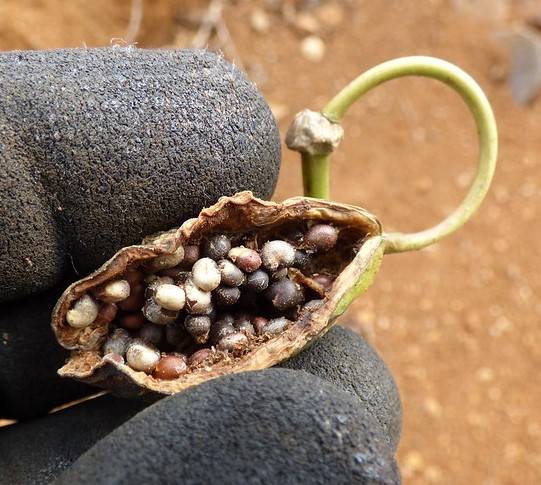
If you can harvest and dry maiapilo seeds, you may be able to grow some new plants. (starrenvironmental.com via Diana Duff/Special to West Hawaii Today)
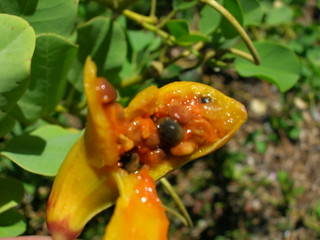
The ripe fruit of the maiapilo can have an offensive odor. (starrenvironmental.com via Diana Duff/Special to West Hawaii Today)
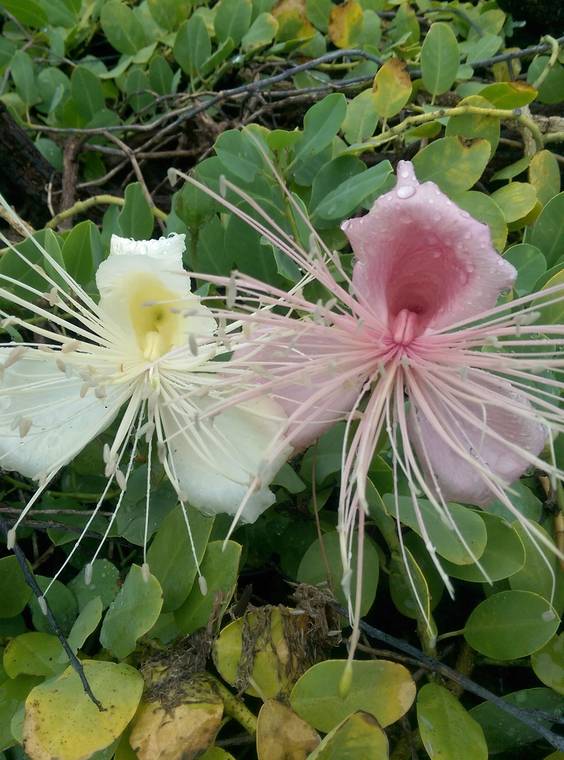
The maiapilo flowers begin to fade to a light pink just before mid-day after their nighttime display. (waikoloadryforest.org via Diana Duff/Special to West Hawaii Today)
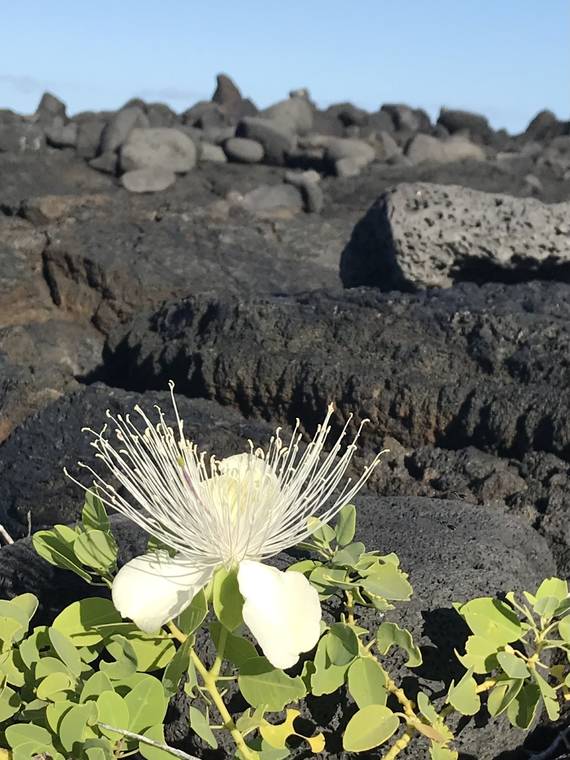
A single maiapilo flower (Capparis sandwichiana) provides a splash of color in the lava fields outside Kona. (Alan Tharp/Special to West Hawaii Today)
The winter months are often dryer than usual in Kona. Looks like the weather gods threw out the rulebook this year though. We are having lots of rain this dry season. Overall, however, we are well advised to plant our gardens in drought tolerant plants anticipating drier weather. Maiapilo is a native Hawaiian xeriscape gem to consider growing at lower elevations in Kona.
The winter months are often dryer than usual in Kona. Looks like the weather gods threw out the rulebook this year though. We are having lots of rain this dry season. Overall, however, we are well advised to plant our gardens in drought tolerant plants anticipating drier weather. Maiapilo is a native Hawaiian xeriscape gem to consider growing at lower elevations in Kona.
I first noticed maiapilo a few years ago on an early morning walk on the beachside path at Kohanaiki. The low growing woody plants were clambering over the rocky dunes on the mauka side of the walk. Their beautiful fragrant white flowers were still open and filling the air along the trail with a sweet lemony aroma. I was charmed by the appearance of the deep-throated center, the two lower petals and the long white whiskery stamens of the nearly four inch blossoms. Some had started to fade, wilting to a pink shade before closing entirely.
Known botanically as Capparis sandwichiana, this Hawaiian native plant is closely related to the caper bush Capparis spinose that is native to the Mediterranean basin. Both plants are in the Capparaceae or Caper family. The European caper bush is known for its buds, which are pickled, sold and consumed as capers.
The beautiful maiapilo bears no edible buds or fruit, though. In fact, the fully ripe fruit has a somewhat unpleasant odor that has been compared to rotting bananas, thus the Hawaiian name mai’a (banana) pilo (stinky).
The prostrate form of the plant grows well at lower elevations near the beach. A more upright form can be found at elevations from sea level to about 500 feet and can reach 10 feet. Both forms are salt and drought tolerant though the upright shrub can be susceptible to breakage in strong winds.
Both the ground cover and the shrub forms have attractive small, oval, olive green leaves in addition to their lovely flower. The flowers usually open after sunset and attract their pollinators with their bright white blooms as well as their appealing fragrance. They usually wilt and close before noon the following day. Once pollinated, a small fruit will form following flowering. The fruit contains many seeds and turns from green to orange as it ripens. The birds who love the seeds know exactly when they are fully ripe and taste best.
If you want to propagate your maiapilo, you’ll have to harvest the fruit before the birds do or put protective bags on the unripe fruit. If you want to save the seeds, harvest the fruit when it is soft but not fully ripe. Separate the small brown seeds from the pulp and dry them completely in a shady location. Once dry, they will store for a while in the refrigerator but lengthy storage can reduce their germination rate.
To encourage germination, soak the dry seeds in water overnight. After a 12- to 24-hour soak, place the seeds about a half-inch deep in soil that drains well. One part potting soil to three pars perlite works well for maiapilo seedlings in a container that allows for good drainage. Only water the medium when it is almost dry.
Though some seeds may sprout in a couple of weeks, some may take months. Patience is required. When the seedlings have put out four or more true leaves, you can plan to transplant them to a larger container. This is a good time to apply a little fertilizer to encourage growth. Do keep the soil fairly dry. Remember, this a drought tolerant plant.
In a few months, your maiapilo may be strong enough to plant in your garden. Choose a hot, sunny location and water occasionally until new leaves and maybe even flowers start to appear. You may want to water deeply every few weeks but be sure the soil drains well.
Once established, the plant will require very little attention. Applying small amounts of fertilizer several times a year can help the plant stay healthy. Very few insects and diseases attack a healthy maiapilo plant.
This plant is practically maintenance free. Maiapilo tolerates pruning well. Some occasional trimming may be required to remove die back or to maintain a desired height and shape. Simply keep the plant healthy so that it will flower and bear fruit enabling you to start new plants. Since this plant is a somewhat endangered native Hawaiian plant, propagation and sharing the plants can help maintain the species.
Though it may be difficult to find maiapilo plants in local nurseries or big box stores, make some calls to try to locate them. If all else fails, watch for fruiting of wild plants and collect seeds from them. Only take a few ripe fruits if you find them, leaving some for the birds to eat and help distribute.
Good luck getting maiapilo growing at your hot, dry low elevation property. The plant will enjoy this location and you will certainly enjoy growing this lovely native Hawaiian plant in your garden.
Diana Duff is a plant adviser, educator and consultant living part time in Kailua-Kona.
^
Gardening Events
Every Saturday: “Work Day at Amy Greenwell Garden” from 9 a.m. to 12:30 p.m. Meet at the Garden Visitor Center across from the Manago Hotel in Captain Cook. Come with a mask and be prepared to practice social distancing. Volunteers can help with garden maintenance and are invited to bring a brown bag lunch. Water and snacks provided. Call Peter at 323-3318 for more information.
Available online: “Brochure on Hawaii Leaf Rust” available at HawaiiCoffeeEd.com/CLRtrifold or by contacting Andrea Kawabata by e-mail at andreak@hawaii.edu, by text at 415-694-1511 or phone at 808-322-4892.
“Video on Little Fire Ants” with new information from the Hawaii Ant Lab and Hawaii Tropical Fruit Growers at https://www.htfg.org/post/learn-about-little-fire-ants
Save the Date: “Coffee Berry Borer & Coffee Leaf Rust Conference 2021,” Aprlil 16-17 from 9 a.m. to 12:30 p.m. on Zoom. Registration is at: https://cbb-clr2021.eventbrite.com
Farmer Direct Markets (check websites for the latest hours and online markets)
Wednesday: “Ho’oulu Farmers Market” at Sheraton Kona Resort & Spa at Keauhou Bay
Saturday: “Keauhou Farmers Market” 8 a.m. to noon at Keauhou Shopping Center
Information on their online market at keauhoufarmersmThursarket.com/onlinemarket
“Kamuela Farmer’s Market” 7:30 a.m. to noon at Pukalani Stables
“Waimea Town Market” 7:30 a.m. to noon at the Parker School in central Waimea
“Waimea Homestead Farmers Market” from 7:30 a.m. to noon at the Waimea middle and elementary school playground
Sunday: “Pure Kona Green Market” 9 a.m. to 2 p.m. at Amy Greenwell Garden in Captain Cook
“Hamakua Harvest” 9 a.m. to 2 p.m. at Hwy 19 and Mamane Street in Honoka’a
Plant Advice Lines
Anytime via email to konamg@ctahr.hawaii.edu or by calling (808) 322-4893 from 9 a.m. to noon on Tuesday and Thursday. Walk-ins accepted 9 a.m. to noon Monday, Tuesday and Friday UH-CES in Kainaliu.


